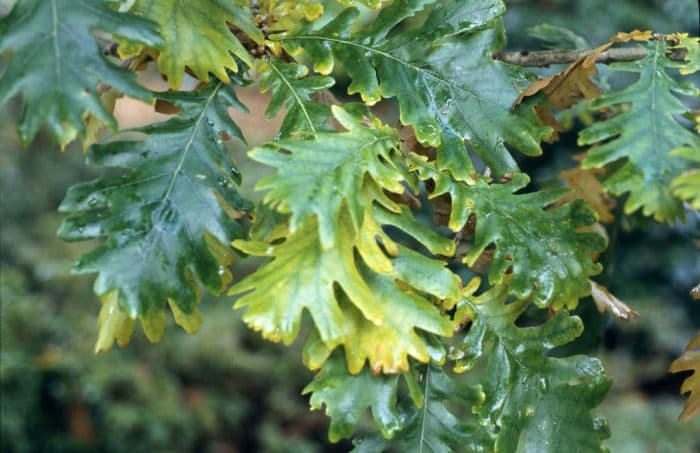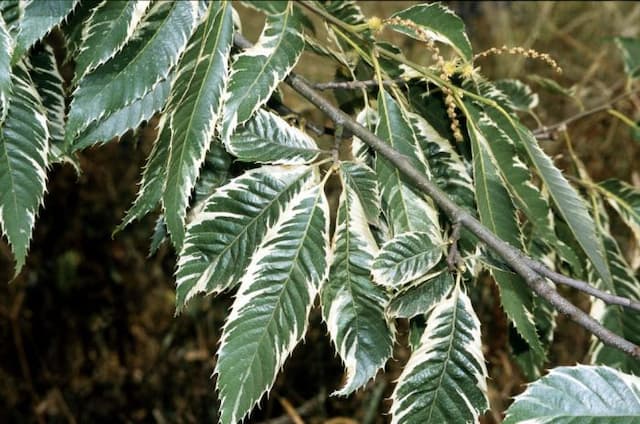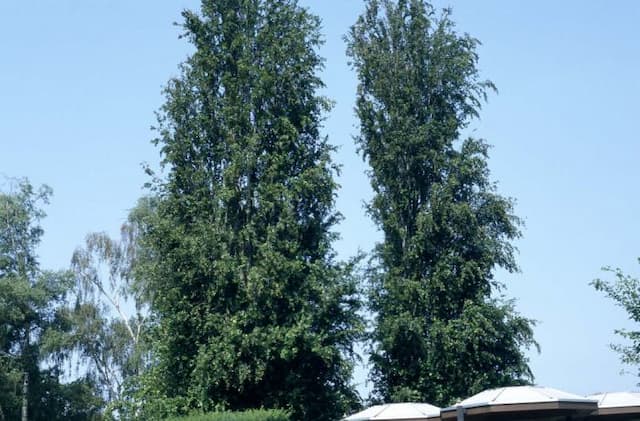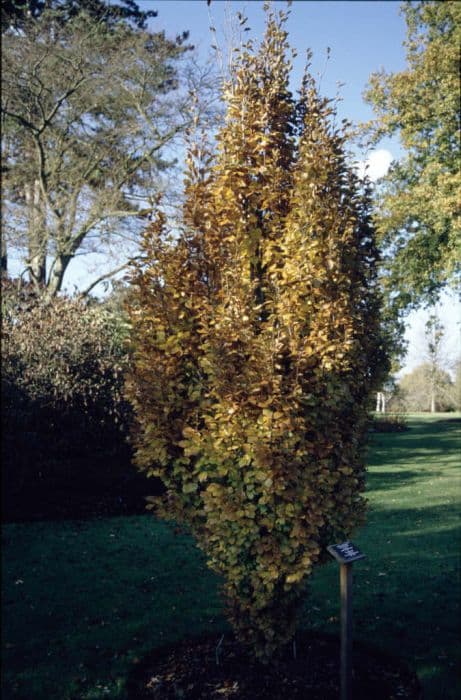Hungarian oak Quercus frainetto 'Hungarian Crown'

ABOUT
Quercus frainetto 'Hungarian Crown', commonly known as the Hungarian Crown Oak, is a majestic deciduous tree renowned for its grandeur and stunning foliage. Characterized by a robust and spreading canopy, this oak is notable for its large, deeply lobed leaves. The leaves are glossy and rich green in color, with a leathery texture. In the autumn, the foliage undergoes a breathtaking transformation, with colors transitioning to a spectrum of yellows and browns, providing a spectacular display before they fall. Its bark is rugged and furrowed, contributing to the tree’s stately presence. Acorns are another distinctive feature of the Hungarian Crown Oak. They are borne in a cup-like structure and are an important food source for local wildlife. The acorns are relatively large and have a classic oval shape with a smooth, shiny appearance. Despite its large stature, the overall shape of the Hungarian Crown Oak is broad and rounded, giving it a balanced look that makes it a striking addition to landscapes. The tree's impressive appearance, marked by its handsome leaves and strong limbs, stands testament to its role as a symbol of strength and endurance in the natural world.
About this plant
 Names
NamesFamily
Fagaceae
Synonyms
Hungarian Crown Oak, Italian Oak
Common names
Quercus frainetto 'Hungarian Crown'
 Toxicity
ToxicityTo humans
The Hungarian Crown oak is generally not considered toxic to humans. However, like many oaks, it produces acorns which contain tannins. If consumed in large quantities, these tannins can cause stomach upset, kidney damage, and other symptoms. It's worth noting that acorn consumption is uncommon, and toxicity cases are rare. The tree's leaves and bark are not typically ingested by humans, so poisoning from these parts is not a common concern.
To pets
The Hungarian Crown oak can be toxic to pets, especially dogs, horses, and livestock, if they consume a substantial amount of the acorns or young shoots. The acorns contain tannins that can cause gastrointestinal distress, vomiting, diarrhea, lethargy, and in severe cases, kidney damage. It is usually not a problem unless the pet eats a large quantity of acorns. Owners should prevent their pets from eating acorns or young shoots from oak trees to avoid the risk of poisoning.
 Characteristics
CharacteristicsLife cycle
Perennials
Foliage type
Deciduous
Color of leaves
Green
Height
60-100 feet (18-30 meters)
Spread
60-100 feet (18-30 meters)
Plant type
Tree
Hardiness zones
5-9
Native area
Southeastern Europe
Benefits
 General Benefits
General Benefits- Aesthetic Appeal: The Hungarian Crown Oak has a stately appearance with a broad and rounded canopy that provides lush greenery and an impressive silhouette in landscapes.
- Shade Provider: Its expansive canopy offers ample shade, making it an ideal tree for parks, gardens, and outdoor recreational areas.
- Wildlife Habitat: It serves as a food source and habitat for birds and other wildlife, supporting biodiversity.
- Durability: The Hungarian Crown Oak is known for its robustness and ability to withstand harsh weather conditions, making it suitable for a variety of climates.
- Long Lifespan: Oaks are generally long-living trees, which means that a single planting can provide benefits for generations.
- Seasonal Interest: It offers visual interest throughout the seasons, with vibrant green leaves in spring and summer, and attractive fall coloration.
 Medical Properties
Medical PropertiesThis plant is not used for medical purposes.
 Air-purifying Qualities
Air-purifying QualitiesThis plant is not specifically known for air purifying qualities.
 Other Uses
Other Uses- Ink and Dye Production: The galls produced by the Hungarian Crown oak can be used to make ink and natural dyes, which have been historically significant for writing and textile coloring.
- Woodworking: The wood of the Hungarian Crown oak is valued for fine woodworking and cabinetry, appreciated for its strength and attractive grain.
- Landscape Design: Because of its imposing size and attractive foliage, this oak is often used as a specimen tree in large gardens and park landscapes.
- Furniture Making: The durable and hardwearing wood of the Hungarian Crown oak is ideal for crafting high-quality, long-lasting furniture.
- Wildlife Habitat: This tree species offers habitat and food for various birds and mammals, with its acorns being a vital food source for wildlife.
- Soil Stabilization: With its robust root system, the Hungarian Crown oak is planted to help prevent soil erosion in vulnerable landscapes.
- Culinary Smoking: Wood chips from the oak can be used for smoking meats and cheeses to impart a distinct flavor.
- Cork Production: Although not a primary use for Quercus frainetto, the bark of closely related oak species is used to produce cork, and any sustainable harvesting methods might apply here as well.
- Holiday Decoration: The leaves and acorns of the Hungarian Crown oak can be used for decorative purposes, especially in autumn-themed arrangements and wreaths.
- Education and Research: This plant can be used as a subject in botanical studies and educational programs to illustrate various aspects of plant growth, anatomy, and ecology.
Interesting Facts
 Feng Shui
Feng ShuiThe Hungarian oak is not used in Feng Shui practice.
 Zodiac Sign Compitability
Zodiac Sign CompitabilityThe Hungarian oak is not used in astrology practice.
 Plant Symbolism
Plant Symbolism- Strength: The plant is a species of oak and oaks are often associated with strength due to their hard wood and longstanding presence in forests.
- Endurance: Oak trees can live for hundreds of years, symbolizing the ability to endure through time and challenges.
- Wisdom: The oak is frequently seen as a symbol of wisdom, with its long life offering a metaphor for the accumulation of knowledge over time.
- Nobility: Due to its impressive stature and value, the oak has been considered a noble tree throughout history, with the 'Hungarian Crown' aspect emphasizing its regal nature.
- Heritage and Tradition: Oaks, in general, are often connected with heritage due to their long lifespans and their common presence in folklore and family crests.
 Water
WaterHungarian Crown Oak trees require deep, infrequent watering to mimic their natural environment. It is best to water newly planted trees at least once a week with 10-15 gallons of water, making sure to soak the root zone thoroughly. For established trees, watering once a month with 20-30 gallons should suffice, depending on the climate and season. During hot, dry periods, increase the frequency but always allow the soil to dry slightly between watering sessions—over-watering can lead to root rot. Reduce watering in the fall to prepare the tree for winter dormancy.
 Light
LightHungarian Crown Oak thrives in full sun, meaning it should receive at least six to eight hours of direct sunlight each day. The best spot for this oak is an open area away from taller structures or trees that might cast shade on it. Its ability to withstand direct sunlight makes it well-suited for open landscapes or large backyards.
 Temperature
TemperatureHungarian Crown Oak is hardy and can tolerate a wide range of temperatures, but it grows best in areas with a temperature range between 50°F and 80°F. It can withstand minimum winter temperatures down to about -20°F and maximum summer temperatures well above 100°F. Consistent temperatures within the ideal range promote the most vigorous growth for the Hungarian Crown Oak.
 Pruning
PruningPruning Hungarian Crown Oak is essential for removing dead, diseased or damaged wood, allowing for a strong structure and healthy growth. The best time to prune is during the dormant season, late fall to early spring, before new growth starts. Prune every 2-3 years to maintain shape and promote the overall health of the tree, taking care to make clean cuts and not to over prune as this can stress the tree.
 Cleaning
CleaningNot needed
 Soil
SoilHungarian Oak prefers a well-draining loamy soil with a pH ranging from 5.5 to 7.5. A mixture of garden soil, compost, and sand or perlite would create an ideal environment for healthy root growth, providing adequate nutrients and aeration.
 Repotting
RepottingHungarian Oak, being a large tree, is not commonly repotted. Instead, it is typically planted in a permanent outdoor location where it can grow without the need for repotting.
 Humidity & Misting
Humidity & MistingHungarian Oak thrives in outdoor conditions where humidity levels are naturally regulated by the environment, without the need for specific humidity control.
 Suitable locations
Suitable locationsIndoor
Not suited for indoor growth; requires open space.
Outdoor
Plant in full sun, well-draining soil, ample space.
Hardiness zone
5-9 USDA
 Life cycle
Life cycleThe life cycle of the Quercus frainetto 'Hungarian Crown', commonly known as the Hungarian Crown Oak, begins with germination, where the acorn, having fallen to the ground in autumn, sprouts in the following spring. Seedling growth follows, characterized by the emergence of a taproot and the initial leaves. The sapling stage is next, where rapid growth occurs, developing a robust trunk and branching structure. After several years, the tree reaches maturity, when it starts flowering and producing acorns, capable of fertilization by wind-dispersed pollen. In its mature phase, which can last for centuries, the Hungarian Crown Oak undergoes cycles of seasonal growth, leaf production in spring, followed by summer vigor, autumn senescence, and winter dormancy. Finally, the tree enters the senescence phase towards the end of its life cycle, when growth slows, and it eventually dies, completing the life cycle.
 Propogation
PropogationPropogation time
Spring-Early Summer
The most popular method of propagation for Quercus frainetto, commonly known as the Hungarian Oak or Italian Oak, is through acorns, which are its seeds. The optimal time for collecting acorns is in the fall when they have ripened and fallen naturally from the tree. To propagate, select healthy acorns without any signs of damage or disease. Before planting, it's beneficial to perform a float test by placing the acorns in water; those that sink are more likely viable and can be sown. Plant the viable acorns immediately in well-draining soil at a depth of approximately 1 to 2 inches (2.5 to 5 centimeters) and space them at least 6 to 8 inches (15 to 20 centimeters) apart. Under the right conditions, acorns will germinate and sprout in the following spring. Seedlings demand consistent moisture but must not be waterlogged, and they require protection from wildlife that may eat the young shoots.









